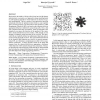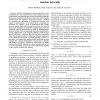769 search results - page 38 / 154 » The Chemical Reaction Model |
SMI
2008
IEEE
14 years 3 months ago
2008
IEEE
Motivated by the ability of living cells to form into specific shapes and structures, we present a new approach to shape modeling based on self-organizing primitives whose behavi...
ICCS
2004
Springer
14 years 2 months ago
2004
Springer
Theoretical modeling of chemical and biological processes is a key to understand nature and to predict experiments. Unfortunately, this is very data and computation extensive. Howe...
SAC
2010
ACM
14 years 1 months ago
2010
ACM
This paper aims at pushing the clear relationship between software service composition and chemical dynamics a step forward. We developed a coordination model where services and c...
GI
2009
Springer
13 years 6 months ago
2009
Springer
: Nowadays, the necessity of safeguarded environments is stronger than ever. The defence of public areas against terroristic threats requires intelligent security assistance system...
CDC
2009
IEEE
14 years 1 months ago
2009
IEEE
— Models of biochemical reaction networks can be decomposed into a stoichiometric part and a kinetic part. The stoichiometric part describes the structural mass flows while the ...


